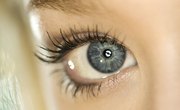
If you are a student of genetics, you have likely learned that genes often come in distinct versions (usually two) called "alleles." One of these alleles is generally "dominant" over the other, the latter being termed the "recessive" copy. You know that everyone carries around two alleles for every gene and gets one allele from each parent.
Taken together, these facts imply that if you have parents with a known genotype for the gene in question – that is, you know what alleles they are capable of contributing – you can use basic math to predict the likelihood of a child of these parents having a given genotype. By extension, you can also predict the chances that any child will display a given phenotype, which is the physical expression of genetically encoded traits.
In reality, reproductive microbiology scuttles these numbers owing to a phenomenon called "recombination."
Simple Mendelian Inheritance
Assume that in a species of cute aliens, purple hair is dominant over yellow hair. In this example, these alleles are represented by the letters P (dominant purple hair) and p (recessive yellow hair). Similarly, assume that round heads (R) are dominant over flat heads (r).
Based on this information, you can determine certain things. If you know that each parent is heterozygous for both of these traits – that is, both the mother and the father have one dominant and one recessive allele at both the hair-color gene location (locus) and the head-shape gene locus – then you know that each parent has the genotype PpRr. The possible genotypes of the offspring are PPRR, PPRr, PPrr, PpRR, PpRr, Pprr, ppRR, ppRr and pprr.
A Punnett square reveals that the ratio of these genotypes is 1:2:1:2:4:2:1:2:1, which in turn produces a phenotypic ratio of 9:3:3:1. That is, for every 16 total children produced by these parents, you would expect 9 purple-haired, round-headed babies; 3 purple-haired and flat-headed babies; 3 yellow-haired, round-headed babies; and 1 yellow-haired, flat-headed baby. These ratios in turn work out to 9/16 = 0.563, 3/16 = 0.188, 3/16 = 0.188 and 1/16 = 0.062. These may also be expressed as percentages by multiplying by 100.
However, nature introduces a critical wrinkle into these numbers: Such calculations assume that these alleles are inherited independently, but the phenomenon of "gene linkage" upends this assumption.
Gene Linkage: Definition
Genes that are close together that code for different traits may be passed along as a unit thanks to a process called "recombination." This occurs during sexual reproduction as part of an exchange of genetic material called "crossing over." The likelihood of this happening in a pair of genes is related to how physically close together the genes are on the chromosome.
Consider a small rainstorm occurring in your town when everyone happens to be outside doing different things. If you get caught in the rain, what are the chances that a randomly selected friend will also be among those soaked? Clearly, this depends on how close to you the selected friend happens to be. Gene linkage works in accordance with the same basic principle.
Recombination Frequency
To determine how close together on a gene two alleles are using reproductive data alone – that is, to solve gene mapping problems – scientists look at the difference between the predicted phenotypic ratios in a population of offspring and the actual ratios.
This is done by crossing a "dihybrid" parent with an offspring that shows both recessive traits. In the case of your alien linkage biology, this means crossing a purple-haired, round-headed alien (which, in the case of a dihybrid organism, has the genotype PpRr) with the least likely product of such a mating – a yellow-haired, flat-headed alien (pprr).
Suppose this yields the following data for 1,000 offspring:
- Purple hair, round head: 404
- Purple hair, flat head: 100
- Yellow hair, round head: 98
- Yellow hair, flat head: 398
The key to solving linkage mapping problems is to recognize that if two genes are not linked, then the offspring's genotypes and phenotypes should be produced in essentially equal amounts. However, as you can see from the results of the data, they are not produced in equal amounts.
For linked genes, the parental chromosomal configurations (aka PpRr, purple-haired round headed, and pprr, yellow-haired flat-headed) are over-represented in number, while the recombinant configurations (Pprr and ppRr) are far fewer.
This allows for the calculation of the recombination frequency, which is simply recombinant offspring divided by total offspring:
(100 + 98) ÷ (100 + 398 + 404 + 98) = 0.20
Geneticists calculate the corresponding percentage to assign the degree of genetic linkage, which has units of "centimorgans," or cM. In this case, the value is 0.20 times 100, or 20%.
The lower the recombination frequency, the more closely the genes are physically linked.
Think about it like this: The closer genes are to each other on a chromosome, the closer they are physically. This physical closeness makes the likelihood of recombination (and thus separation of the linked genes) much lower since they're so close. While recombination frequency isn't a direct measure of this physical closeness, it does give us an estimate of that closeness.
To sum up: You estimate that two genes with a large recombination frequency are likely to be farther apart, while those with a small recombination frequency are likely to be closer together.
References
Tips
- The procedure outlined above works for test crosses with two genes; for test crosses with three genes the procedure is similar but more complicated.
- Note that the recombination frequency will never be more than 50 percent.
About the Author
Kevin Beck holds a bachelor's degree in physics with minors in math and chemistry from the University of Vermont. Formerly with ScienceBlogs.com and the editor of "Run Strong," he has written for Runner's World, Men's Fitness, Competitor, and a variety of other publications. More about Kevin and links to his professional work can be found at www.kemibe.com.
Photo Credits
sperm and egg 4 image by chrisharvey from Fotolia.com
